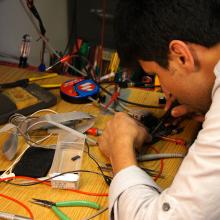Summer Undergraduate Program for Engineering Research (SUPER)
EOL's SUPER Internship provides a unique and valuable experience to prepare engineering students for successful careers.
What Does an Engineering Intern Do?
 While working at EOL, interns help develop new instrumentation and improve EOL's existing suite of NSF/NCAR lower atmosphere observing facilities. Most internships also offer the opportunity to make meaningful contributions to advance atmospheric science research capabilities.
While working at EOL, interns help develop new instrumentation and improve EOL's existing suite of NSF/NCAR lower atmosphere observing facilities. Most internships also offer the opportunity to make meaningful contributions to advance atmospheric science research capabilities.
Interns are encouraged to develop their engineering solutions as they work with and are mentored by professional, experienced engineers and technicians. During the internship, interns have access to many resources such as sophisticated testing and calibration instruments, technical documentation, state-of-the-art fabrication capabilities.
EOL provides an hourly wage and travel support to and from, and housing while in Boulder, CO, and expenses in the field. (Please note that housing is a taxable benefit).
Who Should Apply?
EOL's mission primarily requires software/computer, electrical, mechanical, and optical engineering skills but we encourage all engineering students to apply. Undergraduate students enrolled at accredited U.S. colleges and universities are eligible to apply for SUPER internships. However, note that some projects may require that the intern be (a) a U.S. citizen; (b) lawfully admitted for permanent residence in the United States; or (c) a protected individual as defined by 8 USC1324b(a)(3).
How Do I Apply?
SUPER internship positions are posted mid- to late-November of each year and are typically open through mid-January.
Other NCAR student and internship positions can be found at the UCAR Student/Interns site.
Past Interns on the EOL Undergraduate Engineering Internship Program
"Working at EOL provided me with the chance to put my engineering knowledge and skills to the test. I was able to complete a challenging engineering project with the help of great engineers around me. The project was hands on and it offered me a great learning experience; one which I will never forget."
"How many summer interns can say that their work space included a C-130 Aircraft? The hardware I designed at NCAR was built and actually installed on the aircraft and used for field experiments. I learned how theory I came into the internship with is translated into real-life engineering practices. Working for NCAR reminded me of why I wanted to become an engineer in the first place."
"The internship experience gave me the opportunity to see the application of classroom knowledge to real life engineering practices and the challenges involved. It also exposed me to the research environment which is (and would be) useful in my graduate studies."
Past Internships
2021 SUPER Interns
Peter Walsh, Colorado State University
Sandy Urazayev, University of Kansas
Ammar Siddiqi, Texas A&M University
Jack Scherlag, Princeton University
2020 SUPER Interns
Linus Brogan, Lewis and Clark College
Emily Johnson, University of Pittsburg
David Reents, University of Texas, Arlington
Floriana Ciaglia, Boise State University
2019 SUPER Interns
Abbi Devins-Suresh, Oregon State University
Exploration of Different Techniques to Map and Visualize Ratar Data in the Geosciences using CHORDS (Cloud Hosted Real-time Data Services)
Stefan Suarez, University of Colorado, Boulder
Improving the Accuracy of Data Acquisition Systems on NCAR Research Aircraft
Christopher Bouton, Louisiana Tech University
Real-Time Data Acquisition System Status Webpage
2018 SUPER Interns
Sidarth Raghunathan, Cornell University
Development of a Wavemeter Calibration System for a Water Vaport Differential Absorption LIDAR (WV-DIAL)
Sophia Chen, Brown University
Functionality and Performance Improvements to CHORDS Data Portal
Jessica Barnitz, University of Colorado, Boulder
Design and Development of Storing, Processing, and Visualizing Weather Sensor Data
2017 SUPER Interns
Matt Daily, University of California, Santa Barbara
Extending EOL's post-processing and display capabilities by adding support for 2D files generated from two-dimensional optical array probes
Terrie Yang, University of California, Berkley
CHORDS: Cloud-Hosted Real-Time Data Services for the Geosciences
Alfredo Morales, University of Florida
EOL's Ozone Detection Instrument Data Acquisition System (DAQ)
2016 SUPER Interns
Julian Claudio, University of Colorado Boulder
NCAR Balloon Borne Replicator
Nicholas DeCicco, Rowan University
Convert Legacy GENPRO-I data to the modern NetCDF format
Matthew Daily, University of California Santa Barbara
GNI Analyzer: Creating a Modern Software Framework for a Ground-Based Imaging and Analysis Instrument
Joseph Ronsivalle, University of Pittsburgh
Mobile 449 MHz Wind Profiler